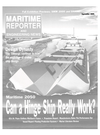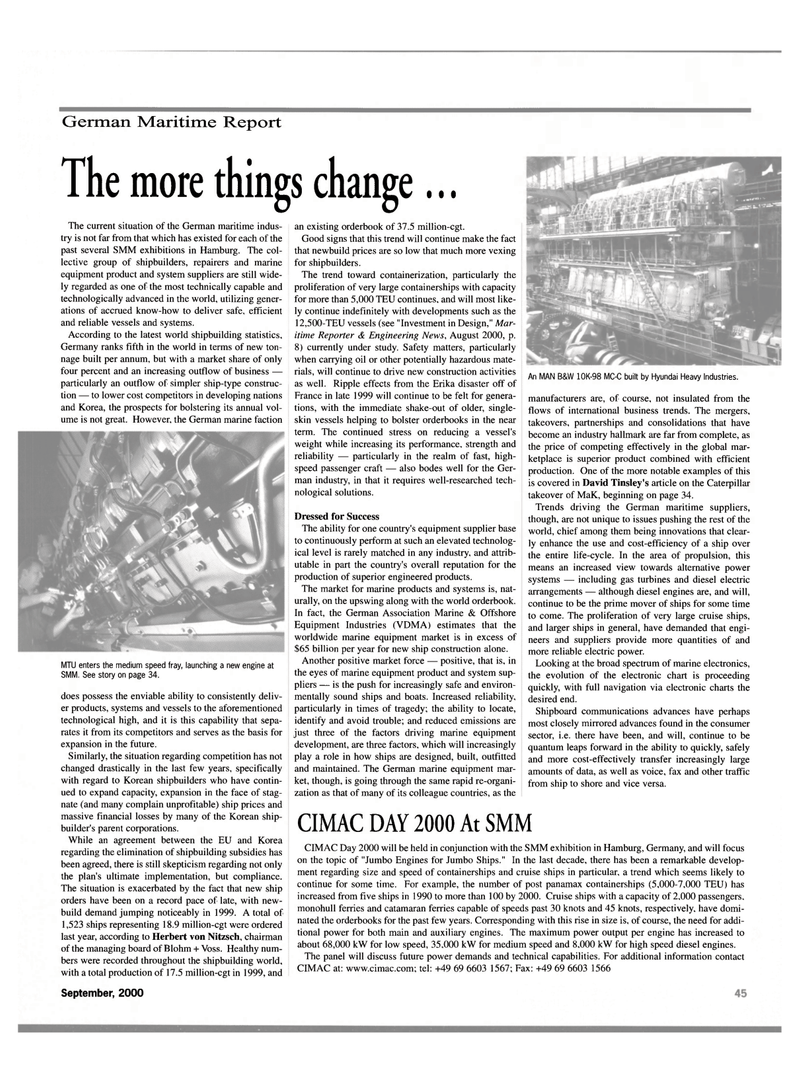
Page 49: of Maritime Reporter Magazine (September 2000)
Read this page in Pdf, Flash or Html5 edition of September 2000 Maritime Reporter Magazine
German Maritime Report
The more things change...
The current situation of the German maritime indus- try is not far from that which has existed for each of the past several SMM exhibitions in Hamburg. The col- lective group of shipbuilders, repairers and marine equipment product and system suppliers are still wide- ly regarded as one of the most technically capable and technologically advanced in the world, utilizing gener- ations of accrued know-how to deliver safe, efficient and reliable vessels and systems.
According to the latest world shipbuilding statistics,
Germany ranks fifth in the world in terms of new ton- nage built per annum, but with a market share of only four percent and an increasing outflow of business — particularly an outflow of simpler ship-type construc- tion — to lower cost competitors in developing nations and Korea, the prospects for bolstering its annual vol- ume is not great. However, the German marine faction
MTU enters the medium speed fray, launching a new engine at
SMM. See story on page 34. does possess the enviable ability to consistently deliv- er products, systems and vessels to the aforementioned technological high, and it is this capability that sepa- rates it from its competitors and serves as the basis for expansion in the future.
Similarly, the situation regarding competition has not changed drastically in the last few years, specifically with regard to Korean shipbuilders who have contin- ued to expand capacity, expansion in the face of stag- nate (and many complain unprofitable) ship prices and massive financial losses by many of the Korean ship- builder's parent corporations.
While an agreement between the EU and Korea regarding the elimination of shipbuilding subsidies has been agreed, there is still skepticism regarding not only the plan's ultimate implementation, but compliance.
The situation is exacerbated by the fact that new ship orders have been on a record pace of late, with new- build demand jumping noticeably in 1999. A total of 1,523 ships representing 18.9 million-cgt were ordered last year, according to Herbert von Nitzsch, chairman of the managing board of Blohm + Voss. Healthy num- bers were recorded throughout the shipbuilding world, with a total production of 17.5 million-cgt in 1999, and an existing orderbook of 37.5 million-cgt.
Good signs that this trend will continue make the fact that newbuild prices are so low that much more vexing for shipbuilders.
The trend toward containerization, particularly the proliferation of very large containerships with capacity for more than 5,000 TEU continues, and will most like- ly continue indefinitely with developments such as the 12,500-TEU vessels (see "Investment in Design," Mar- itime Reporter & Engineering News, August 2000, p. 8) currently under study. Safety matters, particularly when carrying oil or other potentially hazardous mate- rials, will continue to drive new construction activities as well. Ripple effects from the Erika disaster off of
France in late 1999 will continue to be felt for genera- tions, with the immediate shake-out of older, single- skin vessels helping to bolster orderbooks in the near term. The continued stress on reducing a vessel's weight while increasing its performance, strength and reliability — particularly in the realm of fast, high- speed passenger craft — also bodes well for the Ger- man industry, in that it requires well-researched tech- nological solutions.
Dressed for Success
The ability for one country's equipment supplier base to continuously perform at such an elevated technolog- ical level is rarely matched in any industry, and attrib- utable in part the country's overall reputation for the production of superior engineered products.
The market for marine products and systems is, nat- urally, on the upswing along with the world orderbook.
In fact, the German Association Marine & Offshore
Equipment Industries (VDMA) estimates that the worldwide marine equipment market is in excess of $65 billion per year for new ship construction alone.
Another positive market force — positive, that is, in the eyes of marine equipment product and system sup- pliers — is the push for increasingly safe and environ- mentally sound ships and boats. Increased reliability, particularly in times of tragedy; the ability to locate, identify and avoid trouble; and reduced emissions are just three of the factors driving marine equipment development, are three factors, which will increasingly play a role in how ships are designed, built, outfitted and maintained. The German marine equipment mar- ket, though, is going through the same rapid re-organi- zation as that of many of its colleague countries, as the
An MAN B&W 10K-98 MC-C built by Hyundai Heavy Industries. manufacturers are, of course, not insulated from the flows of international business trends. The mergers, takeovers, partnerships and consolidations that have become an industry hallmark are far from complete, as the price of competing effectively in the global mar- ketplace is superior product combined with efficient production. One of the more notable examples of this is covered in David Tinsley's article on the Caterpillar takeover of MaK, beginning on page 34.
Trends driving the German maritime suppliers, though, are not unique to issues pushing the rest of the world, chief among them being innovations that clear- ly enhance the use and cost-efficiency of a ship over the entire life-cycle. In the area of propulsion, this means an increased view towards alternative power systems — including gas turbines and diesel electric arrangements — although diesel engines are, and will, continue to be the prime mover of ships for some time to come. The proliferation of very large cruise ships, and larger ships in general, have demanded that engi- neers and suppliers provide more quantities of and more reliable electric power.
Looking at the broad spectrum of marine electronics, the evolution of the electronic chart is proceeding quickly, with full navigation via electronic charts the desired end.
Shipboard communications advances have perhaps most closely mirrored advances found in the consumer sector, i.e. there have been, and will, continue to be quantum leaps forward in the ability to quickly, safely and more cost-effectively transfer increasingly large amounts of data, as well as voice, fax and other traffic from ship to shore and vice versa.
CIMAC DAY 2000 At SMM
CIMAC Day 2000 will be held in conjunction with the SMM exhibition in Hamburg, Germany, and will focus on the topic of "Jumbo Engines for Jumbo Ships." In the last decade, there has been a remarkable develop- ment regarding size and speed of containerships and cruise ships in particular, a trend which seems likely to continue for some time. For example, the number of post panamax containerships (5,000-7,000 TEU) has increased from five ships in 1990 to more than 100 by 2000. Cruise ships with a capacity of 2,000 passengers, monohull ferries and catamaran ferries capable of speeds past 30 knots and 45 knots, respectively, have domi- nated the orderbooks for the past few years. Corresponding with this rise in size is, of course, the need for addi- tional power for both main and auxiliary engines. The maximum power output per engine has increased to about 68,000 kW for low speed, 35,000 kW for medium speed and 8,000 kW for high speed diesel engines.
The panel will discuss future power demands and technical capabilities. For additional information contact
CIMAC at: www.cimac.com; tel: +49 69 6603 1567; Fax: +49 69 6603 1566
September, 2000 17

 48
48

 50
50
